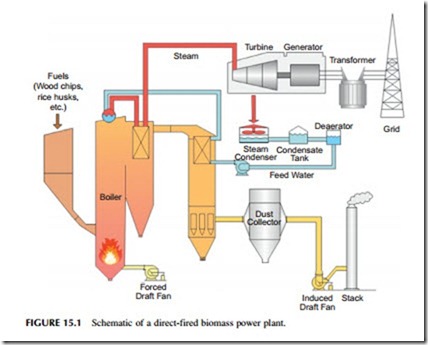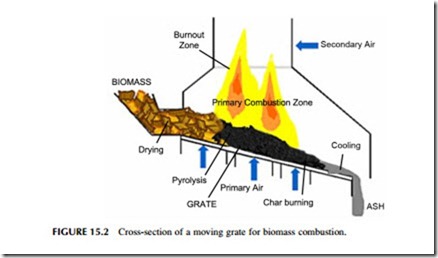DIRECT FIRING
The direct firing of biomass involves burning the fuel in an excess of air inside a furnace to generate heat (Figure 15.1). Aside from heat the primary products of the combustion reaction are carbon dioxide and a small quantity of ash. The heat is absorbed by a boiler placed above the main furnace chamber. Water flows through tubes within the boiler where it is heated and eventually boils, producing steam that is used to drive a steam turbine. Direct-firing technology was developed in the 19th century for coal combustion but has been adapted to other
fuels including biomass. While the heat from a biomass furnace is normally used to generate steam in this way, it may be exploited directly in some indus- trial processes too.
The simplest type of direct-firing system has a fixed grate onto which the fuel is piled and burned in air that enters the furnace chamber from beneath the grate (underfire air). Further air (overfire air) is then added above the grate to complete the combustion process. This type of direct-firing system, called a pile burner, can burn wet and dirty fuel but its overall efficiency is only around 20% at best. The fixed grate makes it impossible to remove ash except when the furnace is shut down, so the plant cannot be operated continuously either, a further disadvantage for this design.
An improvement over the pile burner is the stoker combustor. This type of combustor allows fuel to be added continuously, either from above (overfeed) or from below (underfeed), and has a mechanism for continuously removing ash. The stoker grate was first developed for coal combustion in the 1920s and in the 1940s the Detroit Stoker Co. designed a stoker boiler for wood combustion.
Fuel is distributed more evenly in a stoke grate than in a pile burner, allow- ing more efficient combustion. Air still enters the furnace from beneath the grate and this air flow cools the grate. The airflow determines that maximum temperature at which the grate and thus the furnace can operate and this in turn determines the maximum moisture content of the wood that can be burned, since the dampest wood will require the highest temperature if spontaneous combustion is to be maintained.
For an underfeed stoker combustor, fuel is added from beneath and the grate behaves like a slowly erupting volcano. Ash, when it is formed, falls down the flanks of the fuel pile and is removed from the sides. In an overfeed stoker com- bustor, the grate itself normally moves via some form of chain mechanism allowing fuel to be added from one side and ash removed from the other (Figure 15.2). This type of design is called a mass-feed stoker. A second type, called a spreader stoker, disperses finely divided fuel pneumatically across the whole surface of the grate with finer particles burning in the region above the grate. There are a number of other refinements to the stoker combustor such as an inclined and water-cooled grate. Even so, maximum overall efficiency is only 25%.
Most modern coal-fired power plants burn finely ground coal that is fed into the power plant furnace through a burner and then ignites in midair inside the furnace chamber, a process called suspended combustion. It is possible to burn biomass in this way but particle size must be carefully controlled and moisture content of the fuel should be below 15% (Figure 15.1). Suspended combustion of biomass, while it can provide a higher efficiency, is not widely used in ded- icated biomass power plants. However, it does form the basis for co-firing, which is discussed at greater length in the following section.
The main alternative to the stoker combustor for modern direct-fired bio- mass plants is the fluidized bed combustor. This type of combustor can cope
with fuels of widely differing type and quality, making it much more versatile than a stoker combustor. The fluidized bed contains a layer of a finely sized refractory material, such as sand, that is agitated by passing air through it under pressure so that it becomes entrained and behaves much like a fluid. Fuel is mixed with this refractory material where it burns (when the bed is at its oper- ating temperature) to release heat as in a conventional furnace. Depending on the pressure of the air that is blown through the fluidized bed it will be a bub- bling bed, behaving much like a boiling fluid, or a circulating bed in which the particles are entrained with the air and those that escape the boiler are subse- quently captured in a cyclone filter and recycled. Fuel content within the bed in usually maintained at around 5%.
Fluidized beds can burn a wide range of biomass fuels with moisture content as high as 60%. For low-quality fuels the bubbling bed is preferred, whereas the circulating bed is better for high-quality fuels. Overall efficiency is again only 25% at best, similar to a stoker combustor.
Where the fuel quality is low, gas or coal can be used to raise the bed temperature sufficiently at startup for combustion to commence. An additional advantage of the fluidized bed is that material can be added to the bed to capture pollutants like sulfur that would otherwise result in atmospheric emissions.
Direct-fired biomass power plants typically have a generating capacity around 25–50 MW. This small size, combined with the relatively low combustion temperature in the furnace (biomass is more reactive than coal and so tends to burn at a lower temperature), are the two main reasons for these plants’ low efficiencies compared to coal plants where overall efficiencies above 40% are now common in new facilities.
Improvements are possible. Increasing the size of the typical plant to 100–300 MW would allow larger, more efficient steam turbines to be used, and several 300 MW are being planned in Europe. New small steam turbines that incorporate advanced design features currently found only in large coal plant turbines will also improve efficiency. Adding the ability to dry the bio- mass fuel prior to combustion can result in a significant increase in performance. With these changes, direct-fired biomass plants should be able to achieve 34% efficiency.

